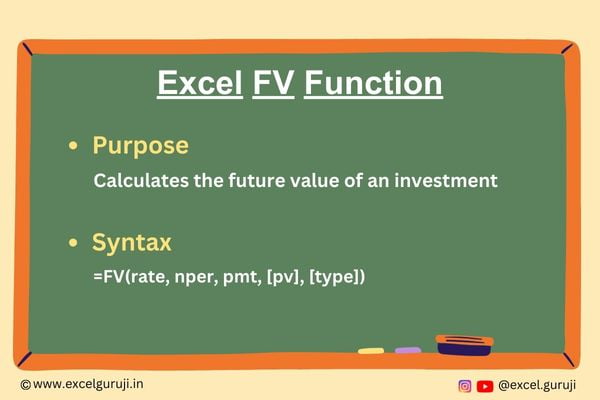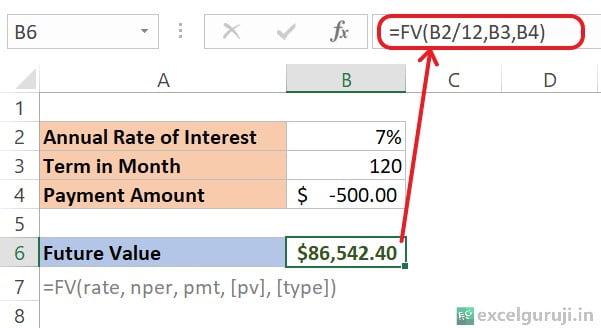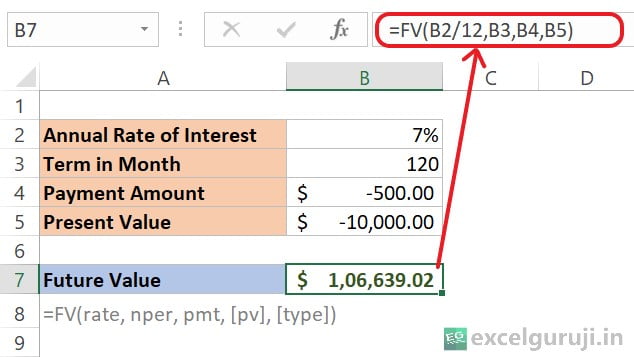Contents
Excel FV Function

When to Use the Excel FV Function in Excel
The FV function1 in Excel comes into play when you need to calculate the future value of an investment based on a series of periodic payments or cash flows. It is a valuable tool for financial analysts, investors, and anyone involved in financial planning.
What Excel FV Function Returns
The Excel FV function returns the future value of an investment based on a series of periodic payments or cash flows.
Syntax of Excel FV Function
The syntax of the Excel FV function is as follows:
=FV(rate, nper, pmt, [pv], [type])
Input Arguments
Here are the input arguments for the Excel FV function:
● rate: The interest rate for each period. It remains constant throughout the annuity’s life.
● nper: The total number of payment periods.
● pmt: The payment made each period, which remains constant throughout the investment’s duration.
● [pv]: The present value, or the total amount that a series of future payments is worth now. This argument is optional, and if omitted, it is assumed to be 0.
● [type]: The timing of the payment. Use 0 if payments are due at the end of the period and 1 if they are due at the beginning. If omitted, it is assumed to be 0.
Examples of the Excel FV Function
Here are few examples demonstrating the usage of the Excel FV function:
Example 1: Basic Usage
Imagine you have recently taken out a home loan to finance the purchase of your dream house. The loan terms include an annual interest rate of 7%, a loan term of 10 years (120 months), and a monthly payment (pmt) obligation of $500.00.
You want to project the future value of your home loan, understanding how much your investment will grow over the 10-year period, taking into account the monthly payments you make.
You can use the FV function as shown below:

Let’s break down the formula: =FV(B2/12,B3,B4)
- B2/12: This part calculates the monthly interest rate. The annual rate of interest is 7%, and when divided by 12, it gives the monthly interest rate.
- B3: This represents the total number of payment periods or the term in months. In this case, it’s 120 months.
- B4: This is the payment amount made each period. The value is -$500.00, indicating an outgoing payment (negative value).
Knowing how much your home loan will be worth in the future helps you see what it means for your money over time. It’s important for planning, guiding your choices about your mortgage and your overall financial health.
Example 2: Including Present Value
If there is a present value involved, such as an initial investment, you can include it in the calculation. For the other parameters, we will use the same values as in the above example 1. Let’s say you have an initial investment of $10,000 in addition to the monthly contributions. In cell B6, input the following formula:

Let’s break down the formula: =FV(B2/12,B3,B4,B5)
- B2/12: This part calculates the monthly interest rate. Divided by 12 for monthly interest rate.
- B3: Payment periods or the term in months.
- B4: Payment amount made each period. The value is -$500.00, indicating an outgoing payment (negative value).
- B5: Present value or initial investment. The value is -$10,000.00, indicating an outgoing cash flow (negative value).
The result you have obtained, $1,06,639.02, is the estimated future value of the investment after making monthly payments of $500.00 for 120 months, starting with an initial investment of $10,000.00, at an annual interest rate of 7%.
Note: We have only covered the use of the [pv] optional argument here; we won’t delve into much detail. If you want to learn more, check out our PMT function. It has detailed examples and explanations for optional arguments.
Extra Notes
● If there is no present value, make sure to include a pmt, and vice versa.
● Ensure that the units for rate and nper are consistent (both annual or both monthly).
● Just remember, negative numbers show money going out, and positive numbers show money coming in.
● When any of the given values are not numbers, you will get a #VALUE! error.
● Payments made at the beginning of the period may result in a higher future value than those made at the end.
● If the Excel FV Function result is way higher or lower than expected, double-check that you are using the right units for each argument.
Practice Workbook
There are two sheets in practice file
Download Free Excel File For PracticeConclusion
In conclusion, the Excel FV function is a powerful tool for financial planning and investment analysis. Whether you are calculating the future value of a series of payments or assessing the impact of different interest rates, the FV function provides a convenient and accurate solution.
Remember, familiarity with Excel functions grows through practice, so don’t hesitate to experiment and apply the FV function in your financial projects. Embrace the FV function today to enhance your Excel skills and make informed financial decisions!
Frequently Asked Questions (FAQs)
Q1: Can the FV function be used to calculate the future value of an investment without periodic payments?
A1: Yes, the FV function can still be used in such cases. Simply set the pmt argument to 0.
Q2: What happens if the interest rate is negative in the FV function?
A2: The interest rate should be entered as a positive value. If the interest rate is negative, it may lead to unexpected results.
Q3: Is the FV function suitable for calculating the future value of irregular cash flows?
A3: The FV function is designed for regular, periodic payments. For irregular cash flows, other financial functions like NPV may be more appropriate.
Q4: Can the FV function handle different compounding frequencies?
A4: Yes, the FV function is flexible and can handle various compounding frequencies, such as monthly or annually.
Q5: Does the FV function consider inflation?
A5: No, the FV function does not explicitly account for inflation. If inflation is a factor, it needs to be considered separately in the calculations.
Click here to download the free Mortgage Calculator Template (With Extra Payment)
Other Related Excel Functions
Excel Mastery: Unveiling the Secrets of the Excel PPMT Function for Precise Principal Payments
Join me on Instagram, YouTube and WhatApp Channel for your daily dose of valuable tips and tricks! Catch insightful videos that will enhance your knowledge and skills. Don’t miss out – follow me now!